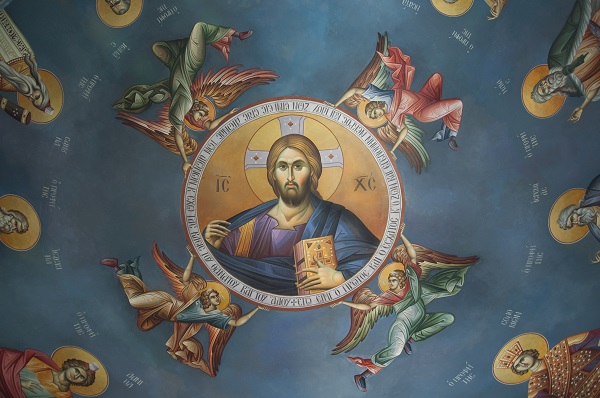“The depiction of the three persons of the Holy Trinity” [3]
20 May 2019[Previous post: http://bit.ly/2Yr1aqQ]
The final conclusion, according to what has been said above, is that the Ungoverned Father can be described precisely as Daniel describes Him according to the relevant resolution of the VII Ecumenical Synod (II Synodic Volume page 905).
Therefore having as given the countenance of the ungoverned Father, the Son and the Holy spirit in no way are we limited in depicting the three persons of the Holy Trinity and to pay respects to them and only (if we hesitate in an worshipful manner) to enable those who are not able to go deeper into the Triadic Dogma to have an initial, simple and accessible picture.
The countenance of the ungoverned Father as Daniel saw it and of the Holy Spirit resembling a pigeon in the Baptism of our Lord ,are pictures which are formed by the non made actions of His Lordship, while that of the Son the physical countenance is existential.
The vision of Daniel in which the prophet sees the Father being formed and painted (white attire, head hair resembling wool) through the non-made actions, and the Son of Man in his existential countenance ,in other words in this which would have taken from Virgin Mary, assisted by the Holy Spirit .

The “as the Son of Man” which prophet Daniel refers to is exactly the same appellation which Christ used many a time for Himself while talking to his disciples and Daniel notes that with remarkable precision so as to show that the coming on the nebulae to the Father is the Son who will take over the authority from Him for the Doomsday as it is made sure by the Evangelist: “Father does not judge anyone in any way but all judgement is delegated to the Son” (Ioannis V 22).
Also the same happens in the one and the only icon of the Baptism in which Christ is depicted existentially (that is in His body) and the Holy Spirit non-existentially in the form of a pigeon taking a form and being co-formed for the human weakness and naturally through the non-made actions of His Lordship. Relation on the other hand exists, to a great degree, between the vision of Daniel and the Creed from the point: ‘‘….and ascended into the heaven and is seated at the right hand of the Father and He will come again in glory to judge the living and the dead”.
When ,now ,an icon painter portrays the vision of Daniel and depicts in the same picture itself the Father taking form through non-made actions and the Son in his existential countenance ,heresy will he fall into from those that some dissenters name?
Once It is given that the Holy Spirit depicts in the Hegemonic of Daniel the countenances of the Father and the Son and they co-exist where then is the illogical? And even Mitrophanis himself (poet of the Triadic Canons which are chanted in the eighth Sound of Midnight of each Sunday. In Daniel`s vision this is going along with the Scriptures) Bishop of Smyrna in the Triadic Canon of the midnight in sound indirect a stresses: Daniel is initiated in the one domain having faced Christ the Judge toward His Father and his Father showing the vision” (view Paraklitiki-book with hymns).
Consequently ,when the two of the three persons of the Holy Trinity co-exist in the one and the same icon ,the one of them taking form through non-made actions and the other existentially ,without even the least contradiction whatsoever, for what reason do we have so many reactions, when the third person is painted ,taking the form of a pigeon and in this way we have all the three persons in one icon?
The Holy icon of the Holy Trinity started and still continues a course of about 350 years throughout Greece, Jerusalem, Sinai, Russia, the Slavic Patriarchates, the Ecumenical Patriarchate and the Holy Mountain. It was taken by the hands and it was paid respects to by saintly existences with a high sense of belief and fatherly-traditional and anti-papal knowledge of an enviable degree.
For a saint to do wrong or to make mistakes however great he may be it is without doubt.
But for so many saints to be wrong for about 3 ½ centuries and for them to pay respects to an Icon full of heresies and even Franco-Latin ,as some claim, it is impossible.
Nothing then dogmatic, in my opinion, nor even ecclesiastical problem is created from giving an account or paying respects to the Icon of the Holy Trinity.
Take an example:
A very beautiful Icon of the Holy Trinity exists on the island of Aegina placed in the winged altarpiece of the namesake church, which was inaugurated by Saint Nectarios in 1906. In front of this Holy Icon the miracle making Saint “took time” before commencing liturgy spreading incense daily and honouring it in many and various ways.
Also another extremely Holy Icon of the Holy Trinity embellishes the winged altarpiece of Kyriako (central church) saint-martyr scete of Kausokalyvia on the Holy Mountain. With this Icon hundreds of confessors and neo-martyrs of our dogma have been spiritually brought up.






